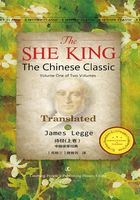
HE PO NUNG
1 How great is that luxuriance,
Those flowers of the sparrow-plum
Are they not expressive of reverence and harmony,—
The carriages of the king's daughter?
2 How great is that luxuriance,
The flowers like those of the peach-tree or the plum
[See] the grand-daughter of the tranquillizing king,
And the son of the reverent marquis!

鹿 is the general name for the deer tribe; specially, it is figured as the spotted axis.純 (t'un) 束, to tie up in a bundle',=the 包之 of last stanza. L. 4. Choo says that如玉 intimates the girl's beauty. I think, with Maou,that the poet would represent by it her virtue rather.
St.3. We must take these lines as the language of the young lady, warning her admirer away. Her meaning gleams out indeed but feebly from them, but I have met with no other exposition of the stanza, which is not attended with greater difficulties. The而, in 舒而=如, so that the phrase= 'slow-like', 'slowly'; much the same is the meaning of 脫 (chwae) 脫感= 'to move','to touch'; as if the character were 撼. The napkin or handkerchief (帨, 拭物之巾) was worn at the girdle.'This 2nd line', says Hoo Yih-kwei, 'warns the man away from her person, as the next warns him from her house.' The Shwoh-wăn defines尨, as 'a dog with much hair',=a tyke; but we may take it with Choo as simply a synonym of 犬. The student will do well to refer to the application which is made of this line in the 1st narrative subjoined by Tso-she to par. 3 of XI. i., in the Ch'un Ts'ëw.
The rhymes are—in st. 1, 麕*, 春, cat. 13; 包*, 誘, cat. 3, t. 2: in 2, 樕, 鹿, 束, 玉, ib., t. 3: in 3, 脫, 帨, 吠,cat. 15, t. 3.
Ode 13. Allusive. THE MARRIAGE OF ONE OF THE ROYAL PRINCESSES TO THE SON OF ONE OF THE FEUDAL NOBLES. The critics, of course, all see a great deal more in the piece than this, and think that it celebrates the wifely dignity and submissiveness of the lady. Whether anything can be determined as to who she was will be considered on the 2nd stanza.
St. 1, 2. L1. 1,2. 穠 (or in Maou, with 衣 at the side) denotes 'the appearance of abundance'. There are great differences of opinion about the tree called t'ang-te. Maou, after the Urh-ya, calls it the e (栘),and is followed by Choo, who adds that it is like the white willow (白楊). Descriptions are given of the constant motion and quivering of its leaves, which would make us identify it with the aspen, a species of the poplar. But the flowers of the tree are what the writer has in view, and this forbids our taking it for a willow or a poplar. Wang T'aou argues moreover that the 栘 in the Urh Ya and Maou is a mistake for 棣.Evidently, from the 2d line of st. 2, the tree in the ode is skin to the peach and the plum. And so say many commentators. Luh Ke (陸璣; during the time of the'Three Kingdoms') makes it out to be the same as the yuh li (薁李), called also the 'sparrow's plum', and other names. The flowers of this are both white and red, and the fruit is distinguished in the same way. I suspect the tree here is the white cherry.
L1.3,4. 肅 is explained by 敬, 'to be reverent' and雝 by 和, 'to be harmonious'. And say the critics,'reverence and harmony are the chief constituents of wifely virtue'.

3 What are used in angling?
Silk threads formed into lines.
The son of the reverent marquis,
And the grand-daughter of the tranquillizing king!


